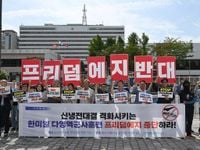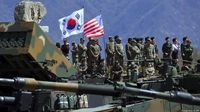On September 15, 2025, the waters off South Korea’s Jeju Island became the stage for a major military display as the United States, South Korea, and Japan launched the Freedom Edge exercise, the most advanced trilateral air and naval drill the region has seen to date. The five-day exercise, running through September 19, brings together the combined forces of all three nations in a coordinated effort to strengthen operational capabilities across sea, air, and cyberspace—a move that has drawn fierce condemnation from North Korea and sparked protests on the streets of Seoul.
Freedom Edge is not just another round of military maneuvers. According to the U.S. Indo-Pacific Command, the drills feature a formidable lineup: U.S. Marine and Air Force aerial assets, enhanced ballistic-missile and air-defense scenarios, medical evacuations, and maritime operations training. South Korea’s Defense Ministry emphasized that these exercises are necessary to counter North Korea’s rapidly advancing nuclear and missile programs and to ensure regional stability in the face of mounting threats. The scope and sophistication of the exercise underscore what the U.S. command described as “the most advanced demonstration of trilateral defense cooperation to date.”
But not everyone is convinced the drills are simply about defense. North Korea, through the powerful voice of Kim Yo Jong, sister of leader Kim Jong Un, lashed out at the exercises, labeling them a “reckless show of strength” and a “confrontational stance” toward Pyongyang. As reported by multiple outlets, including the Associated Press and Kurdistan24, Kim Yo Jong warned, “The reckless show of strength made by them in real action in the vicinity of the DPRK, which is the wrong place, will inevitably bring bad results to themselves.” North Korean state media doubled down, calling the drills a dangerous provocation and reiterating the regime’s position that its nuclear weapons status is “irreversible.”
Kim Yo Jong also took aim at a parallel drill, the Iron Mace tabletop exercise, which is being conducted by South Korea and the United States at Camp Humphreys. This command post exercise, running concurrently with Freedom Edge, is designed to explore the integration of U.S. nuclear capabilities with South Korea’s conventional forces—a move meant to bolster deterrence against North Korean threats. While operational details remain under wraps, the intent is clear: to present a unified front capable of responding to any escalation from the North. As Chun In-bum, a retired South Korean lieutenant general, told DW, “It is an overdue exercise to learn effective ways to prevent and counter a possible North Korean nuclear threat.”
The timing and scale of these maneuvers have not gone unnoticed in the region. On the first day of Freedom Edge, protesters gathered in Seoul, voicing concerns that the drills could ratchet up tensions and provoke further military demonstrations from the North. Historically, North Korea has responded to such joint exercises with its own weapons tests or displays of military might. Just last week, Kim Jong Un visited weapons research facilities and pledged to accelerate both conventional and nuclear military programs—a message that was echoed by North Korea’s permanent mission to the United Nations, which declared on September 15 that the country’s nuclear status was not up for negotiation.
This year’s iteration of Freedom Edge is particularly significant for several reasons. It marks the third time the three nations have conducted trilateral drills of this magnitude, following similar exercises in June and November 2024. It is also the first such exercise under South Korean President Lee Jae-myung, who assumed office in June 2025, and during U.S. President Donald Trump’s second term. While President Lee has expressed a willingness to pursue dialogue and diplomacy with North Korea, his administration’s participation in the drills signals a commitment to deterrence and regional security—a delicate balancing act in a region where the stakes are always high.
Political analysts, including Kim Sang-woo of the Kim Dae-jung Peace Foundation, see these exercises as vital to reinforcing the alliance between Seoul and Washington. He pointed to the 2023 Camp David agreement, where leaders from South Korea, the U.S., and Japan established a nuclear consultative group to strengthen the nuclear umbrella over South Korea in response to North Korea’s growing capabilities. “The agreement at Camp David was the counterbalance to the North and in part it was meant to try to reassure the South that it did not need to develop its own nuclear capabilities because the US would protect it,” Kim Sang-woo explained to DW. President Lee’s government has worked to maintain these security guarantees, even as recent trade disputes and the expulsion of South Korean workers from the U.S. have strained the relationship.
The trilateral drills are also taking place against a backdrop of shifting alliances and intensifying geopolitical competition in the Indo-Pacific. North Korea has deepened its ties with Russia, sending troops and weaponry to support Moscow’s efforts in Ukraine, particularly in the Kursk region, and has maintained close relations with China. Earlier this month, Kim Jong Un traveled to Beijing, where he appeared alongside Chinese President Xi Jinping and Russian President Vladimir Putin at a massive military parade—a public display of solidarity among nations challenging U.S. influence in the region. During his visit, Kim assured Xi that “their countries’ friendship will never change,” signaling a united front that complicates Washington’s strategic calculus.
U.S. President Trump has voiced concerns about the global realignment, warning that America has “lost India and Russia to deepest, darkest China,” following high-profile meetings among Xi, Putin, and Indian Prime Minister Narendra Modi. India, for its part, has pushed back against Trump’s remarks, calling them “unjustified and unreasonable,” even as it faces U.S. trade tariffs linked to its energy ties with Russia. These tensions show that the contest for influence in Asia now extends beyond military maneuvers to include economic tools and diplomatic moves in a rapidly evolving multipolar world.
For now, Freedom Edge and Iron Mace stand as the clearest signals yet that the U.S., South Korea, and Japan are determined to present a united front against North Korea’s nuclear ambitions and the broader shifts in regional power. As the exercises continue through the week, all eyes will be on how Pyongyang—and its allies in Moscow and Beijing—choose to respond. With leaders set to meet at the Asia-Pacific Economic Cooperation summit in Gyeongju at the end of October, the next chapter in this high-stakes regional drama is already taking shape.
In the meantime, the waters off Jeju Island remain a vivid reminder that the balance of power in Northeast Asia is as fragile—and as fiercely contested—as ever.



